
views
X
Expert Source
Renee HughesCertified Professional Aromatherapist
Expert Interview. 14 April 2022.
To mix an essential oil with a carrier oil, start by identifying which carrier oil you want to use based on the essential oil’s aroma profile and intended purpose. Then, mix your carrier and essential oils after measuring them with spoons and dropper bottles. Always consult a medical professional before using an essential oil solution, and never use solutions that are more than 5% essential oil unless you're making a perfume.
Selecting the Right Carrier Oil
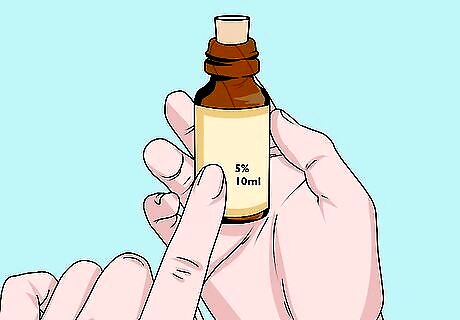
Read the essential oil’s bottle to check for mixing instructions. Certain vials of essential oil are pre-mixed, blended, or designed to be mixed in a certain way. Read an essential oil’s packaging carefully to see if there are any specific instructions regarding the ratio between the essential oil and carrier oil. Consult a medical or aromatherapy professional before you use an essential oil, especially if you have any allergies. Never ingest an essential oil. Never apply an undiluted essential oil to your skin. Make sure that you are not using fragrance oils, which have similar packaging. Unlike essential oils, fragrance oils are synthetic and have no health benefits.
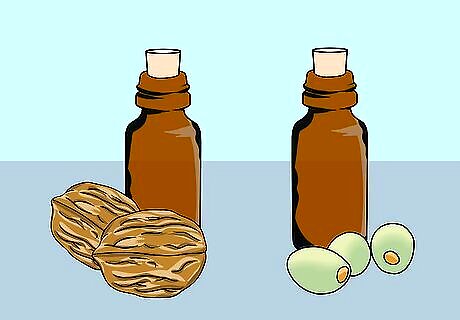
Use olive or sweet almond oil for a basic carrier that is fairly odorless. Olive oil and sweet almond oil are simple carrier oils that have little influence on the scent of an essential oil. If you don’t have any preferences and want to pair your essential oil with a one-dimensional carrier oil, opt for sweet almond or olive oil. Some essential oil enthusiasts dislike the thickness and texture of some olive oils. If you tend to dislike foods that rely on olive oil, try using sweet almond oil instead. Olive oil has a 2-year shelf life, while sweet almond oil usually won’t be good for more than 10 months. Apricot oil is a good alternative to almond oil if you enjoy fruitier scents. It can be a little more expensive, though. Apricot oil has a shelf life of 1 year. If you were storing a carrier oil in the refrigerator to preserve its shelf life, leave it out on your counter for a few hours to let it return to room temperature.
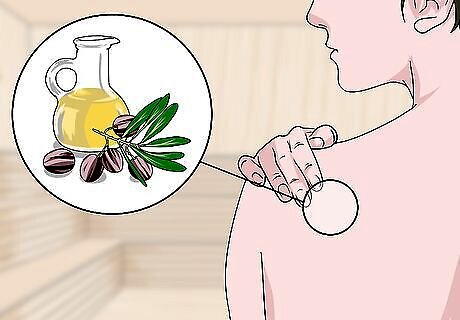
Select avocado, jojoba, or primrose oil for skin treatments. Avocado oil is rich in amino acids, which are soothing and good for your skin. This makes avocado oil a good carrier for people with sensitive skin. Jojoba oil is incredibly close to the natural oils on human skin, which makes it a good choice if you want an inoffensive option. Primrose oil is rich in nutrients that keep skin healthy, but it can be quite expensive. Marula, rosehip, and Argan oil are all rich in antioxidants, which make them great for facial treatments. These oils have a shelf life of 2 years, although it is recommended that you use marula oil within 6 months of the bottling date. Avocado oil has a shelf life of 1 year, jojoba oil will last 5 years, while primrose oil will only last for 6-9 months. Fractionated coconut oil, which will last for 2 years, is a good option for skin treatments if you prefer a thinner texture. If you were storing oils in the refrigerator, leave them out on your counter for a few hours to bring them to room temperature before using them.
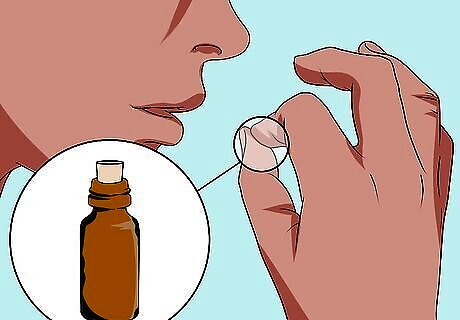
Smell your carrier oil and rub some between your fingers to get a feel for it. If you’re trying to look for a certain texture, scent, or consistency in your mixture, test a carrier oil on its own. With your essential oil’s scent in mind, take a carrier oil and inhale it with the bottle underneath your nose. Put a drop on your finger and rub it between your fingers to test the texture out. If you think it will make a good pairing with an essential oil, try it out! Common carrier oils include olive oil, apricot oil, almond oil, coconut oil, and jojoba oil. Any oil that you can ingest or cook with can be used as a carrier oil. While essential oils are not safe to touch, carrier oils are perfectly fine to handle on their own.
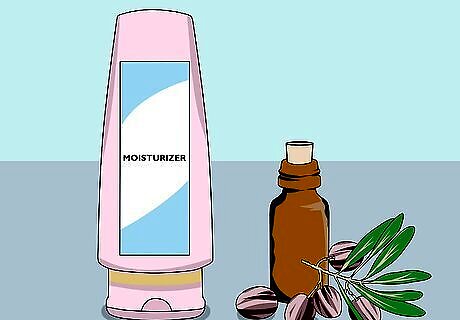
Use an oil-based lotion or cream if you want to modify a product. Any cream or lotion that contains triglyceride—a type of fat found in organic oils—can be used as a carrier. If you want to modify one of your lotions, moisturizers, or hair products, read the product’s ingredient list to see if it contains triglyceride.Tip: If your product is scented, and your essential oil has a strong aroma, you may end up with an odd aromatic profile. That isn’t necessarily bad, just something to keep in mind. For example, peppermint and rose-scented lotion could make a great combination.
Choosing a Dilution
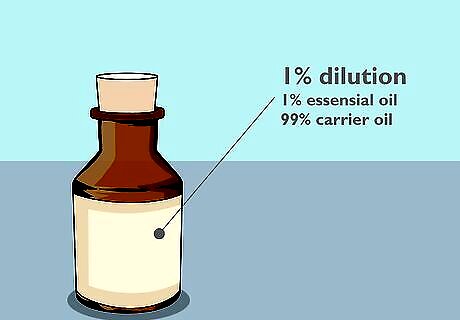
Choose a basic 1% dilution if there are no instructions. A mixture that is 1% essential oil and 99% carrier oil is a safe standard if there are no instructions on the essential oil’s bottle. The largest percentage of an essential oil that you can add to a solution is 2% if you’re touching it, so if you’re between 1-1.5%, you should be fine unless you’re particularly sensitive to a scent or oil. Children younger than 6 years old should never be exposed to a solution that is more than 0.25% essential oil.

Use a dilution between 2.5-10% for massage oils if you’re an adult. Adults can handle a stronger dose of essential oils for massages. Depending on your reaction to an essential oil, mix a 2.5-10% dilution. Mild oils like rose, chamomile, neroli, and sandalwood all pair well with a carrier oil to make a great massage oil. Coconut oil makes a great carrier oil for massages. Essential oil blends are good for massages if you’re experiencing stress, trouble sleeping, or headaches. Find an oil you like and mix it with some coconut oil for a great massage experience! A 2% dilution is really good for massage oils.
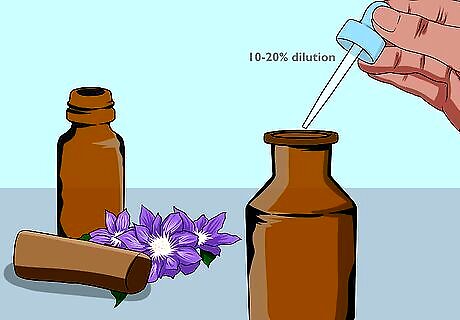
Mix a 10-20% dilution if you're making a perfume. Perfume oils can have a higher concentration of essential oil than massage oils since they aren’t being rubbed into the skin and aren’t covering as much of your body. The higher percentage of an essential oil you use, the stronger the scent will be. Essential oils like sandalwood and lavender are very popular in perfumes. Other common essential oils used in perfume include vanilla and jasmine.

Dilute stronger essential oils so that they’re less than 1% of a solution. Essential oils with particularly potent aromas and textures need to be diluted even further if they’re going to be applied to skin. Cinnamon bark, oregano, and clove need to be diluted further than milder oils, like rose or lavender. Stronger oils like clove, oregano, and lemongrass tend to be good for clearing out your respiratory system. Research individual essential oils online if you aren't sure of their potency. Expert Answer Q How do you mix essential oils in a diffuser? Julie Brow-Polanco Julie Brow-Polanco Master Herbalist & Certified Aromatherapist Julie Brow-Polanco is a Master Herbalist & Certified Aromatherapist with more than 11 years of experience. She is an expert on natural remedies and specializes in using them to support whole-body wellness, particularly immune, digestive, nervous, and reproductive health. Julie earned a Bachelor's Degree in Psychology from Dominican University, a Master Herbalist Certification from The School of Natural Healing, and a Certificate of Aromatherapy from the Pacific Institute of Aromatherapy. Julie is a member of the American Herbalist Guild and a Certified Aromatherapist through the National Association of Holistic Aromatherapy. Julie Brow-Polanco EXPERT ADVICE Answer from Julie Brow-Polanco: Simply add tap water until the fill line of your diffuser and then add your desired oil. If you have one of those portable USB diffusers, add 5 drops of the oil. If you have a larger diffuser, add between 15 to 20 drops, depending on the desired effect.
Mixing a 1% Solution
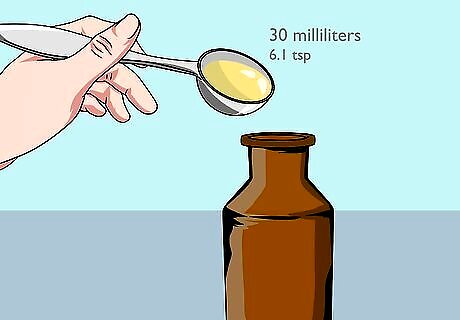
Add 30 millilitres (6.1 tsp) of your carrier oil to a small bottle. Use a measuring spoon to pour out 30 millilitres (6.1 tsp) of your carrier oil. Once you have the proper amount measured out, carefully pour it into a clean bottle. If you’re pouring your oils into a bottle with a small mouth, use a funnel to make sure that all of your carrier oil makes it into the container.Tip: Get a bottle with a pipette that has hash marks for measuring. This will make calculating the amount of essential oil and carrier oil that you’re adding really easy. Do this over a sink or dry towel in case you end up spilling. Oils can be tricky and annoying to clean up. Use an empty dropper bottle to store your mixture if you plan on mixing your solution with something else. The pipette under the cap will make it easier to add your essential oil mixture to an aromatherapy machine or lotion. Make sure that your empty dropper bottle has been thoroughly wiped clean if you were using it for something else beforehand.
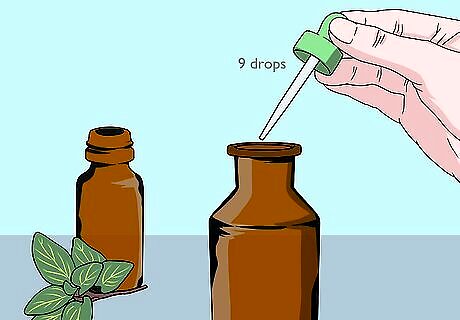
Add 9 drops of essential oil to the carrier oil with a dropper or pipette. Fill the pipette or dropper with your essential oil by pressing the top to create a vacuum in the pipette. Release the top to suck in your oil. Hold the pipette at a 90-degree angle with the top of your carrier oil’s bottle. Count off 9 drops as they come out of the pipette, increasing the angle to hasten the flow as necessary. You may need to squeeze lightly to begin dropping the oil, but be ready to pay attention to how much you’re adding. It may come out quickly. The average droplet is roughly 0.025–0.1 millilitres (0.0051–0.0203 tsp). It can be very hard to measure essential oils using conventional methods unless you’re making a lot of a certain mixture, which is usually a bad idea if your carrier oil has a shelf life. Using the drops from a dropper is the best way to estimate how much oil you’re adding.
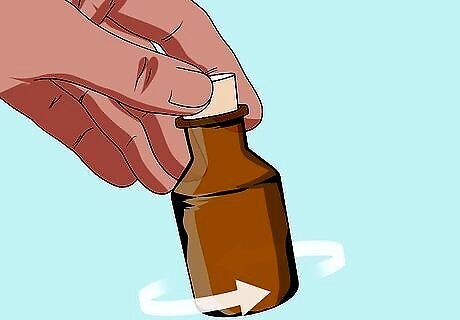
Close the cap on your mixture and swirl it around a few times. Close the cap on your mixture. Flick it around in a circular motion to shake up the solution inside and mix the ingredients together. Avoid shaking your bottle in the event that your cap doesn’t have an airtight seal. If you are mixing your solution in a bowl or larger bottle, feel free to use a spoon to mix it. Add additional carrier oil if you accidentally add too much essential oil. It is always better to play it safe by diluting an essential oil with more carrier oil if you’ve accidentally added too much essential oil.
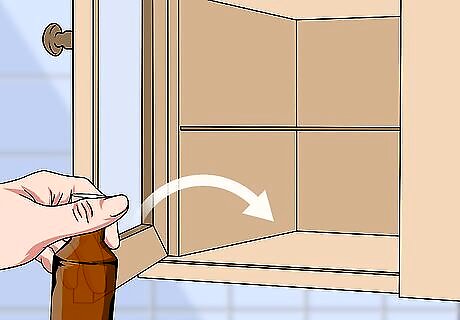
Store diluted essential oils in a cool, dark place. Be sure to keep your mixture in an airtight container and out of direct sunlight. Light and heat will accelerate deterioration, so always store your diluted mixtures somewhere cool and dark, like a cabinet or closet. When stored properly, essential oils by themselves can last for years. The carrier you used may shorten the shelf life, however, so keep that in mind.
Using Essential Oils Safely

Don’t use undiluted essential oils on your skin. If you’re planning on using an essential oil on your skin, always dilute it with a carrier oil. Essential oils are potent on their own, especially if they have a particularly assertive scent or reactive element. If you don’t dilute the essential oil, you risk damaging your skin or causing yourself pain. Don't worry—diluting an essential oil doesn't reduce its potency or ability for healing.Warning: If you do have a reaction to an essential oil, wash your skin with unscented soap and cold water for at least 10 minutes. If you continue to have a reaction, contact poison control or solicit the help of a medical professional. If you come into contact with an undiluted essential oil, you could contract contact dermatitis—an itchy rash related to eczema. Essential oils are unregulated, which means that they aren’t considered safe for ingestion.
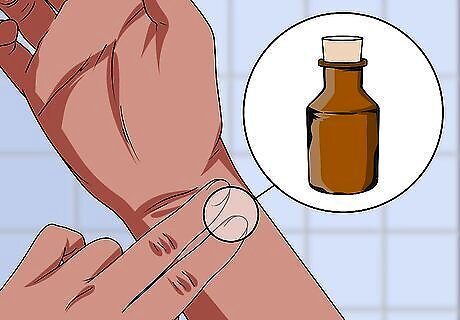
Test a mixture on your inner forearm before applying it. Carefully drop a small droplet of your mixture on your inner forearm. If you feel any pain or irritation, wipe it off immediately and wash your arm with soap and water. If you don’t feel any negative effects after 2 days, the mixture is probably safe to use on your skin.
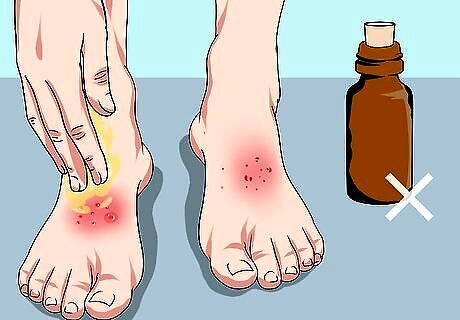
Avoid using essential oils to treat medical conditions. While an essential oil mixture may have therapeutic elements, they are not medicine. You cannot use essential oils to treat physical conditions, and you should always consult a medical professional before using an essential oil for anything other than aromatherapy. Avoid using essential oils if you are pregnant, even if you simply plan on using them for aromatherapy. If you do choose to use essential oils during pregnancy, always consult a licensed aromatherapist first.




















Comments
0 comment